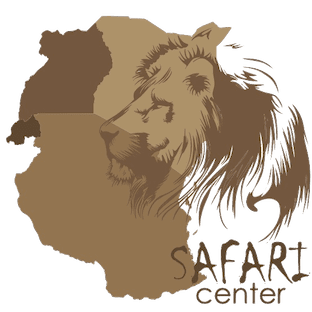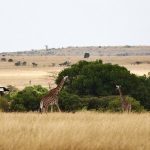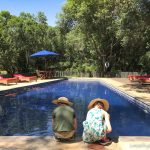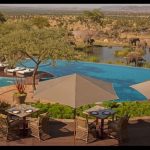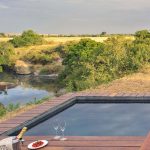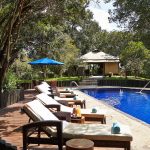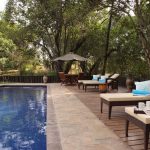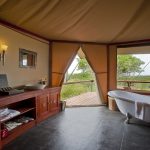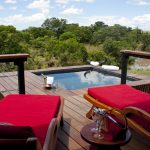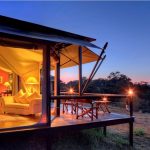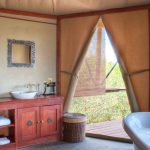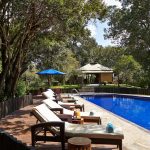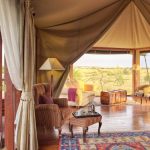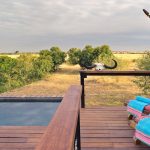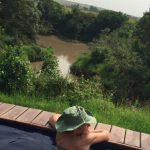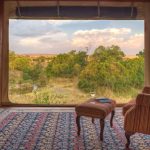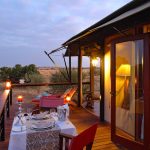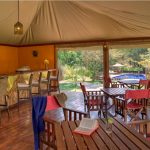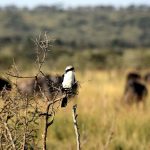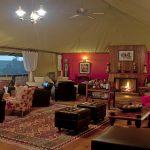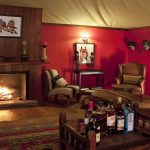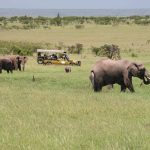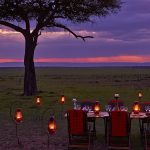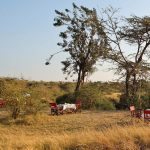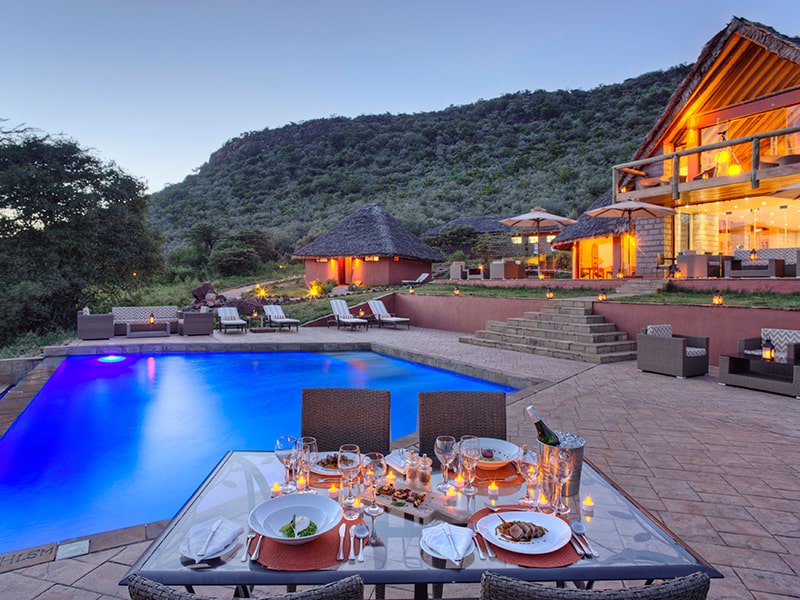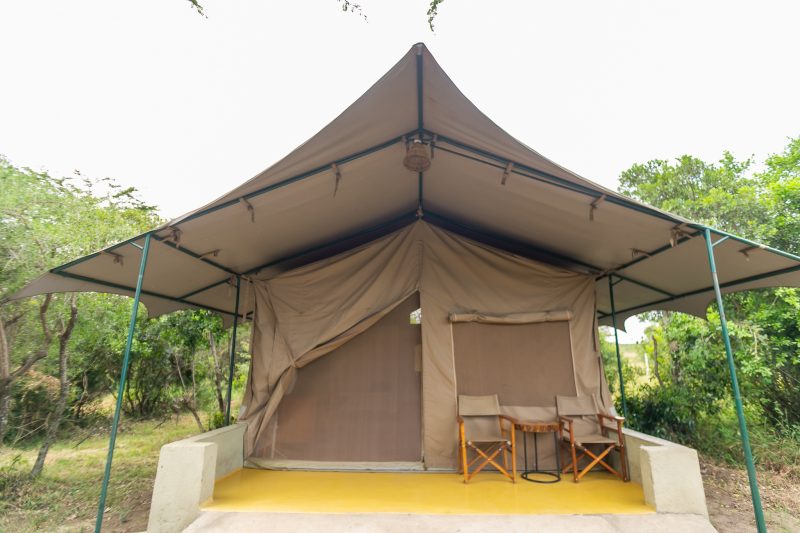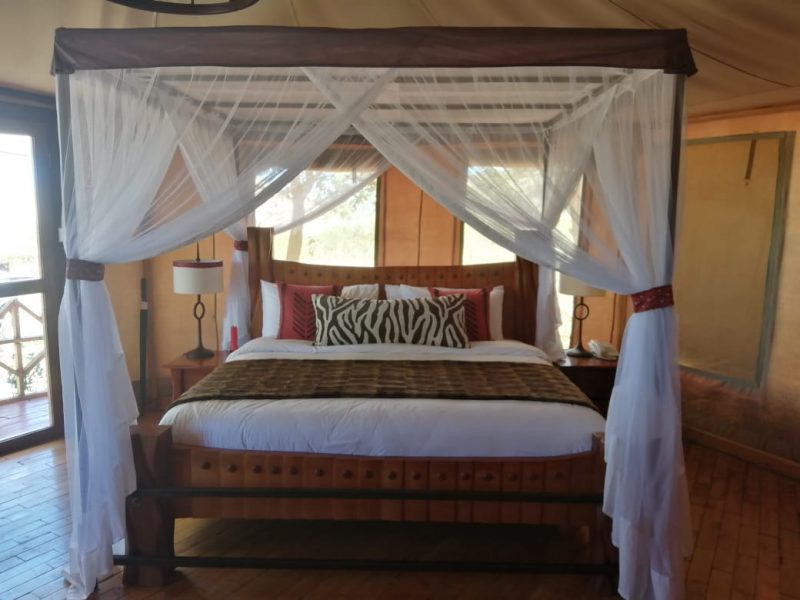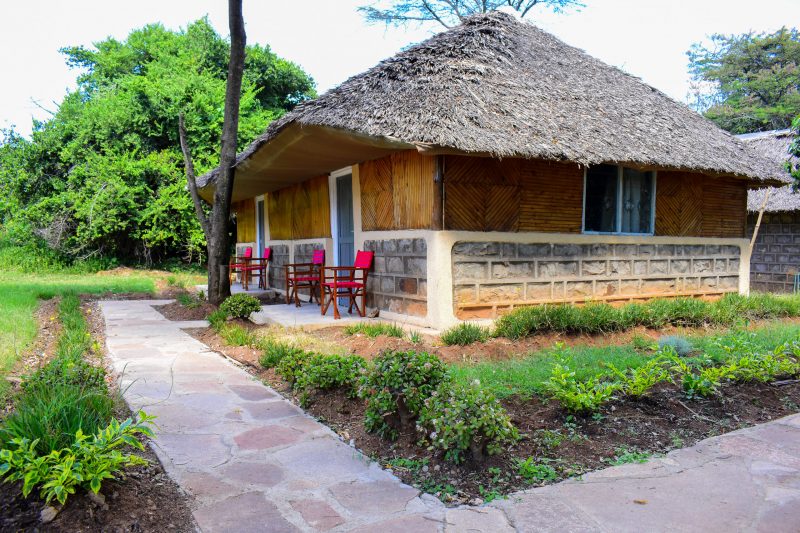Shs. 166,740/- ground-package per person per night at Olare Mara Kempinski
Valid until 15 October 25
Ground-packageTriple – Shs. 150,370/- per person per night Double – Shs. 166,740/- per person per night Single – Shs. 248,160/- per night |
Includes1 night accommodation on full-board in a luxury tent 1 shared morning & evening game drive in a 4×4 land cruiser within Olare Motorola conservancy Exquisite champagne bush breakfast overlooking Ntiakitiak river Sundowner and cocktails Selected alcoholic and non-alcoholic drinks |
Children0 to 8 years – not allowed 8 to 12 years sharing with adults – 50% of adult rate 1 adult and 1 child – single rate + 50% of adult sharing rate 8 to 12 years in their own room – 75% of adult rate |
To book this package please fill out the following form or simply email us on safaris@safari-center.com
Olare Mara Kempinski
Olare Mara Kempinski is at the heart of its own private conservancy. It promises all the luxury. It also delivers a classic under-canvas safari experience. The lodge is in a rolling savannah, across which wanders a glorious pageant of wildlife. This exclusive tented camp blends the welcome and vibrancy of Maasai culture with the opulence of a five-star experience. It features 12 tents. It has a central lounge and dining area, a tented bar set deep within a forested glade and a shaded swimming pool. Olare Mara Kempinski Maasai Mara delivers the ultimate fusion of untamed wilderness and elegance. Meanwhile, action includes campfire cocktails, sundowners on the plains, game drives, guided walks, balloon safaris and horse-riding. There is also a colourful range of culture.
Visit a Maasai village
A visit to the Maasai Mara region would not be complete without a visit to the nearby Maasai boma, which delivers a unique insight into this age-old culture. The community with which the Olare Mara Kempinski has established a relationship is located just a short drive away.
Inside the village
Inside the village, you can meet the people and visit a typical Maasai home. You can also learn about Maasai daily life, enjoy dancing and singing displays and visit the community’s own handicrafts market. The vibrancy of Maasai culture is unrivalled. It typically centres around a brushwood enclosure into which the community’s cows and goats gather at night. The building of the village is in line with age-old traditions. Each woman has her own hut. The male society follows a complicated hierarchy of age-sets, warrior-clans, elders and laibons.
Maasai celebrations
Maasai life is built upon a platform of joyous celebrations. They mark the passage of time from birth to death, the dispensation of justice, the changing of the seasons and the treasuring of the Maasai’s precious cattle. The traditions have remained unchanged for centuries. Such celebrations typify a way of life. They have remained untouched by the arrival of the technological age. The village visits are utterly authentic. These visits promise unrivalled photo-opportunities.
Traditional Maasai hospitality
It begins with a traditional welcome from the Maasai morans, who will escort you from your vehicle and into the brushwood enclosure. Here you will find all the children who are too young to go to school and their mothers. Typically, the village elders will be on hand to welcome you. The young morans will demonstrate the traditional kindling of fire. Several long notes will then be sounded on an eland horn. This summons the Maasai from the surrounding villages to come and meet the guests. In the meantime you will be invited to enter a traditional Maasai home.
Maasai huts
Each low grey hut is constructed by the women. They are made from wooden poles and cow dung. Entering through a low narrow door, you will find yourself in a dark room. This rooms has a central cooking hearth also made from cow dung. There will be a few low stools around the hearth and a wooden sleeping platform made from stretched hides. You’ll be invited to take a seat. and your host will tell you more about the Maasai way of life. It’s a relaxed experience with plenty of laughter.
Checking out of the hut
Emerging from the hut you will find that a colourful group of ladies has arrived. They will be dressed in their finest beadwork. They will sing while performing some traditional dances. It is customary that the guests are invited to join the dance. Then the young morans will perform their own songs, dances and jumping displays. Finally you will be invited to visit the simple display of beadwork and carving that has been laid out on the grass.
Communal funding
The visits provide a valuable contribution to the finances of community life. The proceeds from the visits, which are passed directly to the community, have so far financed the construction of a water tower, and the establishment of a health centre. The ladies, meanwhile, use the money they earn from their handicrafts to establish self-help groups.
Day game drives
All of our guests are invited to enjoy two game drives per day. Game drives can take place in the morning, afternoon, evening or at night. This is your chance to observe creatures great and small. Often awe-inspiring, a game drive allows you to be part of the wilderness. Managed in cooperation with its ancient guardians, the Maasai, this is a realm where you will rarely see another safari vehicle, where the savannah is yours, and where you will often find yourselves as the only spectators. During the season, you can also witness one of the world’s most stunning natural events: the annual migration of over one million wildebeest and their attendant wildlife cast. Our custom-built six-person safari vehicles offer comfort, panoramic viewing, dedicated safari guides, refreshments on-board. They can also incorporate picnic breakfasts or lunches and evening sundowners in the bush.
What you can see
This unique ecosystem hosts over 95 species of mammals. Highlights include: elephant, buffalo, hippo, Maasai giraffe, topi, Coke’s hartebeest, Grant’s and Thomson’s gazelle, zebra, impala, Kirk’s dik-dik, bushbuck, waterbuck, red duiker, baboon, vervet monkey, blue monkey, red-tailed monkey, nocturnal bush baby and tree hyrax. Predators include lion, cheetah, leopard and hyena. There are 550 recorded bird species, 5 of which are globally threatened.
An ornithological extravaganza
Boasting over 550 resident and migratory species, this unique region shelters an incredible array of both regionally and globally threatened birds. Easily spotted on the plains are the common ostrich, secretary bird, ground hornbill and bustard. Also plentiful are crowned plover, red-necked spur fowl and helmeted guinea fowl, while along the rivers African fish eagle, Egyptian geese, yellow-billed stork, sacred ibis and blacksmith plover abound. There are also 53 species of raptors, to include augur buzzard, black-shouldered kite, bateleur eagle and 6 species of vulture. Finally, this is the only place in Kenya where you can see the rare Schalow’s turaco.
Hot-air balloon safari
Until you have floated above the glory of the Maasai Mara, and looked down on the drama of the wildlife theatre below, it’s hard to appreciate just how magical a balloon safari can be. The essential ‘once-in-a-lifetime experience’, a balloon safari has it all – drama, adventure and fascination.
What to expect
Every flight is different: you might find yourself sailing past eagle chicks in their nests; or above snorting, chortling hippos in their pools. Floating along in silence, you’ll look down on the mosaic of patterns created by galloping zebras, leaping antelope and browsing buffalo. A silent observer, high above them, you present no threat to the wildlife. So you may catch a cheetah in pursuit of its kill, a pair of antelopes with their horns locked in combat, a pride of lions at play. Drifting through the cool of the morning air, you can track the wildebeest as they career across the plains; or look down on the giraffe as they browse the tree-tops. Dipping low over the churning waters of the river, you’ll have a bird’s eye view of the huge basking crocodiles.
Preparations
Our balloons take off early to catch the breeze, so you’ll leave camp at around 5 am. Arriving at the take-off point, you’ll meet your fully-qualified balloon pilot. Now is the time to watch as the massive multi-coloured balloon is slowly filled with hot air. At first the balloon lies prone so as to allow the burners to fill it with hot air. Eventually, however, it will rise slowly into the pink-grey of the dawn sky. At a signal from the ground staff, you will be invited to clamber into the balloon’s stout wicker basket. When everyone is settled into their seats, the sandbags will be cast off; the lift-off team will stand back. And the balloon will rise into the cool of the morning air. It’s an awe-inspiring moment.
Bon voyage
Driven by the wind, and guided by jets of hot air from its gas-burners, the balloon will fly for a period of around 45 minutes. Then, as the morning sun rises, it will descend to a gentle ‘controlled-landing’ on the plains. Celebrating your flight with a glass of sparkling wine, you will receive your individualized ‘flight certificate’ before sitting down to a full English breakfast. Later, there will be a leisurely game-drive back to the camp.
Horse-back riding
It’s an experience you will never forget – a ride through the wilderness on horse-back. It’s not just that you’ll enjoy views, or that you’ll benefit from the wildlife guidance of a very experienced team, it’s also that because you’re out of the safari vehicle, and on four legs rather than two – you’ll be an actual part of the great theatre of the wild. You’ll ride alongside herds of zebra or giraffe, you’ll encounter buffalo herds as they graze the plains. You may ride past stately eland, or kongoni, perched atop their anthill mounds. You may see the hippo in their pools and you’ll certainly encounter some fascinating bird life. Best of all, during the annual migration you can actually ride with the migrating herds – a once in a lifetime experience.
About the stables
The dedicated Ride Kenya stables are located in the Olare Motorogi conservancy, just a short drive from the camp. Established by safari professionals Martin Dodwell and Ali Mundy, they offer a selection of superb horses, all of which are safari-trained. Choose from mounts of various breeds, size and temperaments.
Escorted rides
Every ride is escorted by a professional safari rider who will guide you on a circular ride that takes in savannah, dry river beds, hippo pools and glades where plains game graze. A standard ride lasts for two hours. Should you wish to ride for longer, or further, the ride can be tailored to your specification; and can even include a picnic breakfast or lunch. Rides must be booked in advance, but can be arranged at very short notice. Simply ask our front desk to enquire about availability.
Please note
Riders must be reasonably proficient, which Ride Kenya qualifies as ‘around 50 times in the saddle’. All riders will be given a thorough briefing before the ride commences, they will also be required to demonstrate their competency with a brief ride around the stable’s central arena. Riders must also be above the age of fourteen.
Walking in the wild
Offering a refreshingly alternative view of the wilderness, a guided nature walk promises panoramic vistas, gentle exercise, and a fascinating insight into the world of African trees, flowers, insects, reptiles, birds and animals. It also offers the ultimate contrast to the game drive. Only when you venture into the wilderness on your own two feet, will you really appreciate its splendour. And only when you are a part of the landscape can you absorb its magic. Slow in pace, wide-ranging in scenery and led by one of our trained safari guides, our Olare Motorogi nature walk can be tailored to your preference in terms of distance and pace. And it can happen early morning or late afternoon – just as you desire.
Ornithological walks
With over 1,070 species of birds, Kenya has the second-highest country bird list in Africa, while the Maasai Mara national reserve and it boasts 550-recorded species. Glorious in its diversity, the Kenyan birdlife ranges from the regal raptors that patrol above, to the iridescent sunbirds that sip the flowers below. And in between there’s a vibrant showcase of turacos, kingfishers, rollers, larks, herons and geese to be enjoyed. For the amateur and serious ornithologist alike, we offer a range of half or full day outings which can be custom-tailored to match the specific interests of your ornithological party. The services of our naturalist and up-to-date bird checklists are included, and picnics, bush lunches, camp suppers and sundowners can be scheduled to suit your needs.
Location
The Maasai Mara national reserve and the surrounding conservancies constitute one of Kenya’s most famous wilderness areas. They also provide the backdrop against which is enacted what has been dubbed ‘the greatest wildlife show on earth’, the annual migration of the wildebeest.
Ecosystem
Nature knows no boundaries, so although the Maasai Mara technically belongs to Kenya, and the Serengeti national park to Tanzania, both are part of the same mighty Serengeti ecosystem. This is a wilderness where endless khaki-coloured savannah washes up to the foot of the blue-grey Oloolola Escarpment; where low-lying shrub dapples the plains, and where tree-lined rivers meander. A place unchanged by the passage of time, the Mara is essential Africa. Sometimes raw, always dramatic, this is a wilderness of evocative splendour and inspiring grandeur. Often raw, sometimes violent, the drama of this wildlife theatre is unrivalled. Nowhere on earth can you find a wilderness so breathtakingly beautiful and yet so serenely pristine.
In perfect harmony
In practical terms, it helps to know that the Maasai Mara is a national reserve. This means that it is an area where human beings are allowed and where domestic livestock may roam. However, we carefully protect the wildlife and the well-being of the wildlife always takes precedence over human activities. You will see that some people refer to the Mara as the Masai Mara and the Maasai Mara. Both spellings are technically correct. But the area is officially Masai Mara, while the term Maasai describes the Maa people. The conservancies that surround the Mara are a natural extension of the Serengeti eco-system. Unlike the national reserve, however, they represent a series of joint-venture initiatives between the Maasai people and the conservation sector.
